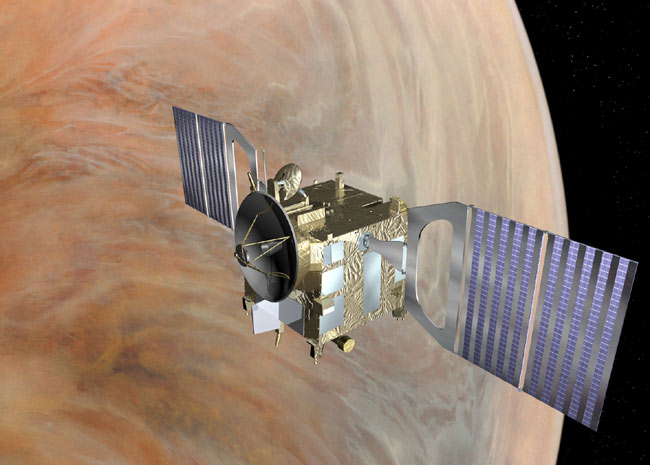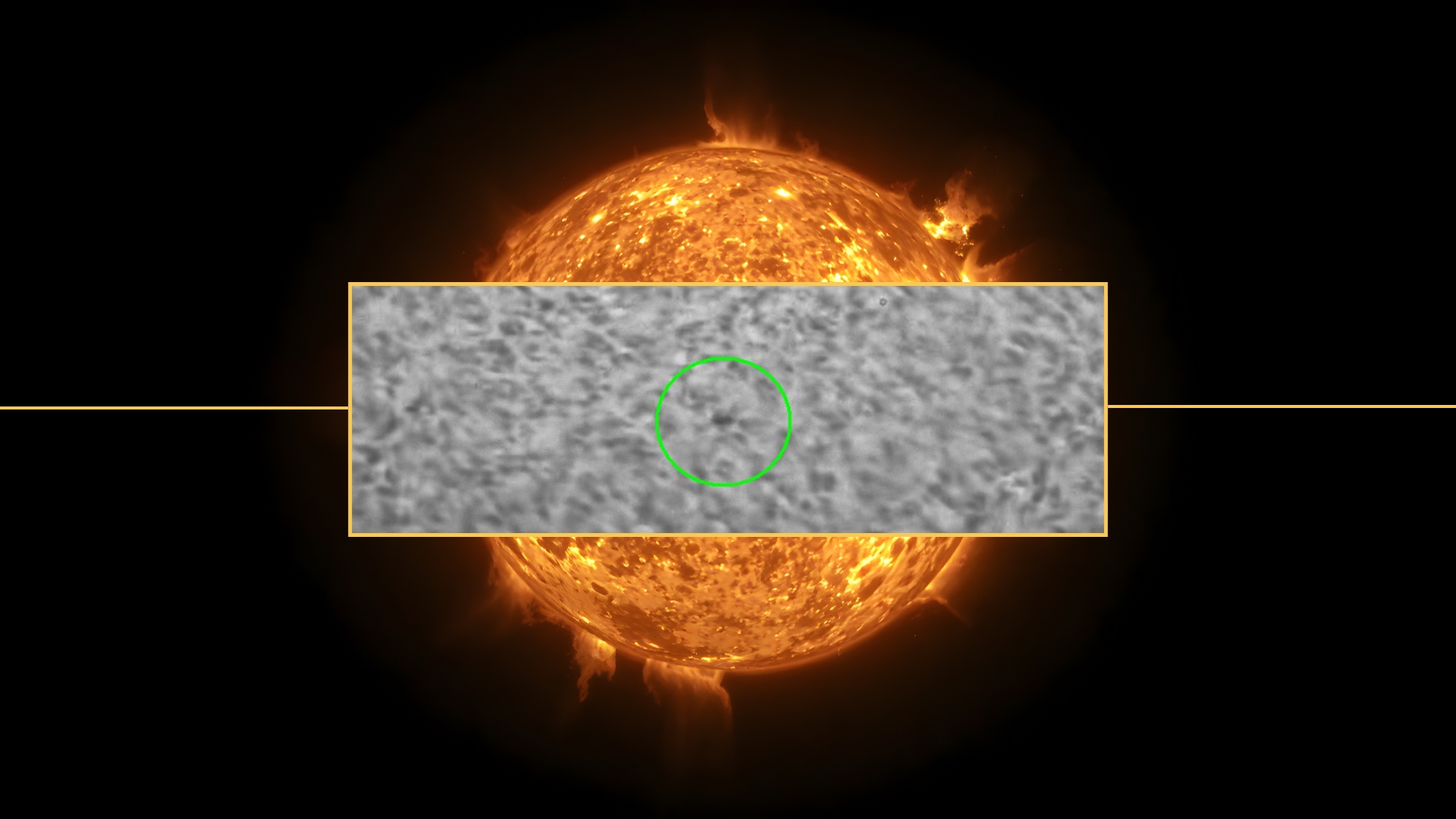A Cloudy Target: Europe's Venus Express Probe to Explore Shrouded Planet

Despite adelayed start, Europe's first Venus probe is preparing to launch spaceward on amission to study the planet's soupy atmosphere and, hopefully, answer many ofthe naggingquestions raised by past expeditions to the cloudy world.
While aninsulation contamination problem preventedtoday's planned launch of the European Space Agency's (ESA) Venus Express probe,inspections of the spacecraft and booster are underway, ESA officials said Tuesday.
Thespacecraft is in "good status" and engineers are confident they will have theprobe ready to launch from Baikonur Cosmodrome, Kazakhstan atop a Soyuz-Fregatrocket before its flight window closes on Nov. 24, they added.
VenusExpress is expected to fly the first dedicated mission to Venus in 25 years followingNASA's Magellan spacecraft in 1989, and is the ESA's second swiftly-built non-Earthorbiter to bear the name "Express." Its predecessor, MarsExpress, is currently circling the red planet.
"Thescience from these two missions will help to understand our place here," VenusExpress project manager Don McCoy, who also worked on the Mars Expressspacecraft, told SPACE.com in an e-mail interview.
Many of theorbiter's seven instruments were derived from the ESA's Mars Express andcomet-bound Rosettaspacecraft, which eased development costs and scheduling, making it the spaceagency's fastest-built science satellite to date.
"Clearly,the availability of existing spare instruments from Rosetta and mars Expressallowed us to shorten the usual development time for a scientific satellite,"McCoy said.
Breaking space news, the latest updates on rocket launches, skywatching events and more!
The $226million (220 million Euro) mission is expected to arrive at Venus in April 2006,he added.
UnderstandingVenus
Unlike the Magellanprobe, which used radar to generate a surface map, Venus Express has its sightsset on the planet's thick, turbulent and toxic atmosphere.
"VenusExpress does not have the same mission as Magellan, aside from the clear objectiveof studying Venus," McCoy said. "[Ours] is an orbiter designed to study theatmosphere globally over a long period, whereas Magellan was designed to studythe surface."
Among otherthings, researchers hope to understandwhat role the "greenhouse effect" of trapped carbon dioxide, water vapor andsulphuric aerosols gases played in the heating of Venus' atmosphere to itscurrent average surface temperature of about 869 degrees Fahrenheit (465 degreeCelsius).
To performits mission, Venus Express carries three spectrometers, one magnetometer, ahigh-resolution camera, radio tools and a plasma-watching instrument dubbedASPERA similar to one aboardMars Express.
"A gooddeal of the time and effort of scientific satellites are spent in the developmentof very specialized instruments," McCoy said. "When a spare can be taken, witha few modifications to tune it to a new mission, there is a clear advantage oftime and money."
Thespacecraft's Planetary Fourier Spectrometer - also legacy instrument from MarsExpress - will record the temperature of Venus' atmosphere all the way down tothe surface, where researchers hope the instrument may be able to search forvolcanic activity.
"It would be great to discover an active volcano and toprove that the planet still is active geologically," said H?kan Svedhem, VenusExpress project scientist, in an ESA interview.
Venus Express does sport two almost wholly originallyinstruments. The probe's Venus Express Magnetometer and Venus Monitoring Camera- the high-resolution imager - were built specifically for their mission, ESAofficials said.
Spacecraft engineers reused a Rosetta sensor design for themagnetometer and a few leftover parts from the Mars probe's High-ResolutionStereo Camera.
"In principle, it was necessary to resist changes as much aspossible to avoid schedule and cost impacts," McCoy said, adding that his teamdid embrace change "aggressively" where necessary. "The experiences on MarsExpress were definitely an asset in this balance because the knowledge...could beapplied directly from one satellite to the next."
A differentplanetary express
While ESA officialshave billed the 2,799-pound (1,270-kilogram) Venus Express as a near-twin ofits Mars-watching counterpart, the spacecraft is much more than a mere clone.
Because theVenusian environment differs substantially from that of Mars due to itslocation closer to the Sun, engineers modified the heat insulation covering VenusExpress' 5-foot by 6-foot by 4.5 foot (1.5-meter by 1.8-meter by 1.4-meter)exterior to survive higher temperatures and radiation levels.
Temperaturesaround Venus are four times higher than those experienced by Mars Express,prompting engineers to rearrange their orbiter's 23 layers of insulation andswath them in gold - as to the black used on the Mars probe - to reflectsunlight, and enlarged the spacecraft's radiators to handle the additionalheat, ESA officials said.
Spacecraftdesigners were also able to shed some weight by decreasing the size of VenusExpress' two wing-like solar panels.
Because thespacecraft will be flying much closer to the Sun than Mars Express sunlightappears twice as powerful, allowing the probe to rely on about 64 square feet (sixsquare meters) of solar cells, which are also more heat-tolerant than thoseused aboard the Mars orbiter, ESA officials said.
But thatweight savings was offset by the need for added propellant due to additional gravitationalforces Venus Express will have to fend off to maintain an orbit around itstarget planet.
Venus'gravitational pull is almost as strong as Earth's and about eight times that ofMars, ESA officials said. That added gravity, plus the added pull of the Sun,required engineers to pack about 20 percent more fuel aboard Venus Express,they added.
When fullyfueled, Venus Express is designed to carry 1,256 pounds (570 kilograms) of fuel- almost half the probe's total mass - into space.
A two-daymission (on Venus, that is)
While VenusExpress is expected to spend about 15 months studying its cloud-covered target,the mission will span only two of the world's exceedingly long days.
"We use theVenus sidereal day, [about] 243 Earth days, as a convenient measure of missionduration," McCoy said, adding that Venus Express is prepared a missionextension should it be needed. "The satellite carries sufficient reserves foran extension of another two Venus days if the health is adequate, but this willbe decided later in the mission."
Before VenusExpress' mission managers can even think about beginning science operationsaround Venus - let alone extending the spaceflight - they must first launch theorbiter into space. ESA officials are confident that engineers will be able toclean up the insulation contamination and again prepare the spacecraft forflight before its launch window closes on Nov. 24.
"The Soyuzrocket we are using has a very good record so I am very hopeful that it willwork out well," Svedhem said before the currentcontamination hitch.
But the launchdelay hasn't dampened the excitement for McCoy, who feels Venus Express willlink him - robotically, at least - to another world.
"I find I'mdrawn to look at the sky more than usual," McCoy said, adding that both Venusand Mars are clearly visible in the night sky at Baikonur Cosmodrome. "It ismagical to stand on one planet and feel connected to two other planets in theskies overhead in such a manner."
- Venus and Earth: Worlds Apart
- Launch Date Slips for Europe's First Venus Probe
- Image Gallery: Beneath the Clouds of Venus

Tariq is the award-winning Editor-in-Chief of Space.com and joined the team in 2001. He covers human spaceflight, as well as skywatching and entertainment. He became Space.com's Editor-in-Chief in 2019. Before joining Space.com, Tariq was a staff reporter for The Los Angeles Times covering education and city beats in La Habra, Fullerton and Huntington Beach. He's a recipient of the 2022 Harry Kolcum Award for excellence in space reporting and the 2025 Space Pioneer Award from the National Space Society. He is an Eagle Scout and Space Camp alum with journalism degrees from the USC and NYU. You can find Tariq at Space.com and as the co-host to the This Week In Space podcast on the TWiT network. To see his latest project, you can follow Tariq on Twitter @tariqjmalik.
